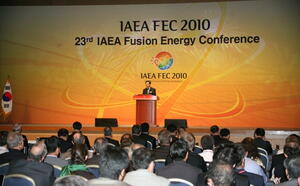Nuclear Fusion Prize 2010 awarded
15 Oct 2010
During the 2010 Fusion Energy Conference, held in Daejeon, Korea this week, the Nuclear Fusion Prize was presented to the 2009 and 2010 winners on 11 October 2010.
The prize winner for 2009 is Steve Sabbagh from the Department of Applied Physics and Applied Mathematics, Columbia University, New York (US). He received the award as the lead author of a landmark paper which reports record parameters of beta in a large spherical torus plasma, and presents a thorough investigation of the physics of resistive wall mode (RWM) instability. The paper makes a significant contribution to the critical topic of RWM stabilization.
The recipient of the 2010 award is John Rice, principal research scientist on the Alcator Project at MIT's Plasma Science and Fusion Center, Cambridge, Massachusetts (US), as the lead author of a seminal paper that analyzes results across a range of machines in order to develop a universal scaling that can be used to predict intrinsic rotation. The timeliness of this paper is the anticipated applicability of this scaling to ITER.
The Nuclear Fusion Prize is awarded annually to recognize outstanding work published in the journal.
Read more at www.iaea.org


